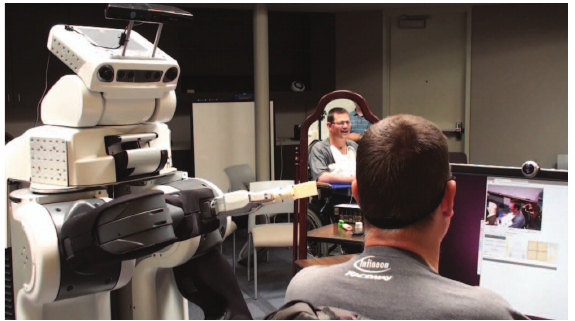Robots for Humanity: Using Assistive Robotics to Empower People with Disabilities
By Tiffany L. Chen, Matei Ciocarlie, Steve Cousins, Phillip M. Grice, Kelsey Hawkins, Kaijen Hsiao, Charles C. Kemp, Chih-Hung King, Daniel A. Lazewatsky, Adam E. Leeper, Hai Nguyen, Andreas Paepcke, Caroline Pantofaru, William D. Smart, and Leila Takayama
NOTE: This is an overview of the entire article, which appeared in the March 2013 issue of the IEEE Robotics & Automation Magazine.
Click here to read the entire article.
Assistive mobile manipulators (AMMs) are mobile robots that physically manipulate the world to provide assistance to people with disabilities. They have the potential to one day serve as surrogates and helpers for people with disabilities, giving them the freedom to perform tasks such as scratching an itch, picking up a cup, or socializing with their families.
This article is a progress report on a project which has the aim of empowering motor-impaired users to take full advantage of AMMs to effectively perform a wide range of tasks, including new tasks from their own imaginations. A team of researchers conducted a project on assisted robotics with the help of Henry Evans and his wife, Jane. Henry is a mute quadriplegic as a result of a brainstem stroke, and Jane is his primary caretaker. They approached the research team in hopes that Henry could one day use a robot as a surrogate for his paralyzed body.
Over a one-year period the project, dubbed “Robots for Humanity” by Henry, was primarily carried out in Henry and Jane’s home. Researchers met with the couple four times for multiday research workshops to design, develop, user test, and iteratively improve robotic software and hardware tools. This simulation environment allowed Henry to practice complex tasks in the comfort of his home.
The project was organized around three broad categories of robotic assistance with the Willow Garage PR2 robot: with manipulation near the user’s body, manipulation of objects in the environment, and with social interaction. These challenges are closely related to activities of daily living (ADLs) such as feeding, using the toilet, and maintaining hygiene; instrumental ADLs which include housework, food preparation, and shopping; and enhanced ADLs such as hobbies and social interaction. These activities have been shown to be important for quality of life, but are difficult for many people with motor impairments. During the initial needs assessment Henry and Jane each filled out a questionnaire rating the value and usefulness of the robot assisting with various tasks that they considered to be high priority and acceptable for robot assistance. For example, Henry wanted the robot to feed him, but Jane considered the task too dangerous because of choking hazards. Involving both the care receiver and the caregiver are thought to be important for the future success of AMMs since caregivers are likely to use and interact with AMMs in distinct ways.
Robots are notorious for coping poorly with environmental variations such as clutter, illumination, objects, mechanisms, pets, people, and more, all of which can impact the robot’s performance. The goal of this research was to enable AMMs to handle real-world variations found in homes and to empower motor-impaired users to take full advantage of AMMs to perform a wide range of tasks. Henry and Jane’s help assessing the strengths and weaknesses of the team’s software and hardware highlighted the importance of tools that allow end users to author robot behaviors.
By actively involving Henry and Jane in this participatory design process, tangible progress was made in developing assistive capabilities that are both useful and usable. The research methods used in this study enabled Henry to scratch (see figure) and shave himself , retrieve an object in his home, and socially interact through speech and gesture.

Henry controlling the PR2 from a GUI to scratch his face.
The authors report on Henry Evans’ interaction with the robot, and on special interfaces and techniques for social interaction that have been developed as a result of the project, which is being continued beyond its initial year.
ABOUT THE AUTHORS
Tiffany L. Chen (tiffany.chen@gatech.edu) is at Georgia Institute of Technology, Atlanta, Georgia.
Matei Ciocarlie (matei@willowgarage.com) is with Willow Garage, Inc., Menlo Park, California.
Steve Cousins (cousins@willowgarage.com) is with Willow Garage, Inc., Menlo Park, California.
Phillip M. Grice (phillip.grice@gatech.edu) is at Georgia Institute of Technology, Atlanta, Georgia.
Kelsey Hawkins (kphawkins@gatech.edu) is at Georgia Institute of Technology, Atlanta, Georgia.
Kaijen Hsiao (hsiao@willowgarage.com) is with Willow Garage, Inc., Menlo Park, California.
Charles C. Kemp, (charlie.kemp@bme.gatech.edu) is at Georgia Institute of Technology, Atlanta, Georgia.
Chih-Hung King (aaking@si.gatech.edu) is at Georgia Institute of Technology, Atlanta, Georgia.
Daniel A. Lazewatsky (lazewatd@engr.orst.edu) is at Oregon State University, Corvallis, Oregon.
Adam E. Leeper (aleeper@stanfored.edu) is at Stanford University, Stanford, California.
Hai Nguyen (hai@gatech.edu) is at Georgia Institute of Technology, Atlanta, Georgia.
Andreas Paepcke (paepcke@willowgarage.com) is with Willow Garage, Inc., Menlo Park, California.
Caroline Pantofaru (pantofaru@willowgarage.com) is with Willow Garage, Inc., Menlo Park, California.
William D. Smart (smart@oregonstate.edu) is at Oregon State University, Corvallis, Oregon.
Leila Takayama (takayama@willowgarage.com) is with Willow Garage, Inc., Menlo Park, California.






